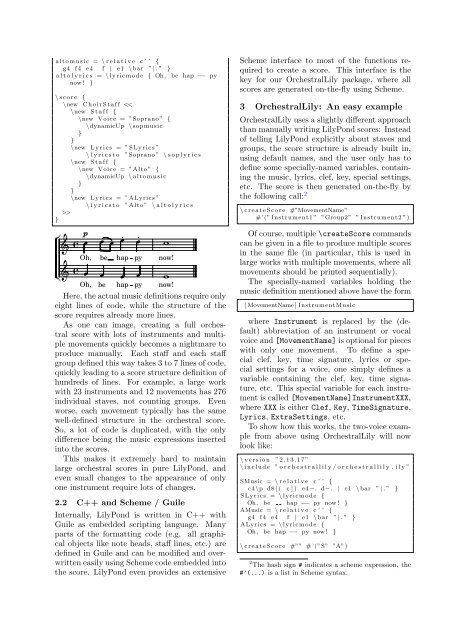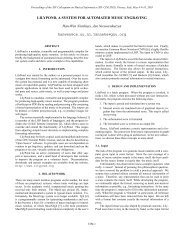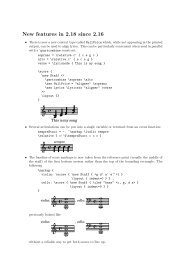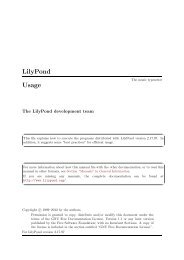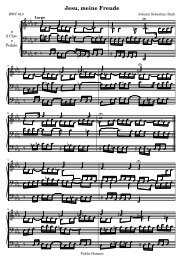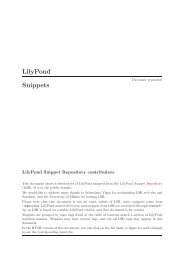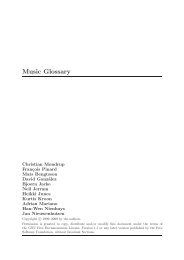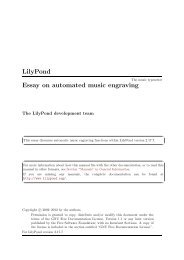OrchestralLily: A Package for Professional Music ... - LilyPond
OrchestralLily: A Package for Professional Music ... - LilyPond
OrchestralLily: A Package for Professional Music ... - LilyPond
Create successful ePaper yourself
Turn your PDF publications into a flip-book with our unique Google optimized e-Paper software.
a l t o m u s i c = \ r e l a t i v e c ’ ’ {<br />
g4 f 4 e4 f | e1 \ bar ” | . ” }<br />
a l t o l y r i c s = \ lyricmode { Oh, be hap −− py<br />
now ! }<br />
\ s c o r e {<br />
\new C h o i r S t a f f ><br />
}<br />
<br />
<br />
<br />
<br />
<br />
p <br />
Oh,<br />
<br />
Oh,<br />
<br />
be<br />
<br />
be<br />
<br />
<br />
hap<br />
<br />
hap<br />
<br />
py<br />
<br />
py<br />
<br />
now!<br />
<br />
now!<br />
Here, the actual music definitions require only<br />
eight lines of code, while the structure of the<br />
score requires already more lines.<br />
As one can image, creating a full orchestral<br />
score with lots of instruments and multiple<br />
movements quickly becomes a nightmare to<br />
produce manually. Each staff and each staff<br />
group defined this way takes 3 to 7 lines of code,<br />
quickly leading to a score structure definition of<br />
hundreds of lines. For example, a large work<br />
with 23 instruments and 12 movements has 276<br />
individual staves, not counting groups. Even<br />
worse, each movement typically has the same<br />
well-defined structure in the orchestral score.<br />
So, a lot of code is duplicated, with the only<br />
difference being the music expressions inserted<br />
into the scores.<br />
This makes it extremely hard to maintain<br />
large orchestral scores in pure <strong>LilyPond</strong>, and<br />
even small changes to the appearance of only<br />
one instrument require lots of changes.<br />
2.2 C++ and Scheme / Guile<br />
Internally, <strong>LilyPond</strong> is written in C++ with<br />
Guile as embedded scripting language. Many<br />
parts of the <strong>for</strong>matting code (e.g. all graphical<br />
objects like note heads, staff lines, etc.) are<br />
defined in Guile and can be modified and overwritten<br />
easily using Scheme code embedded into<br />
the score. <strong>LilyPond</strong> even provides an extensive<br />
Scheme interface to most of the functions required<br />
to create a score. This interface is the<br />
key <strong>for</strong> our <strong>OrchestralLily</strong> package, where all<br />
scores are generated on-the-fly using Scheme.<br />
3 <strong>OrchestralLily</strong>: An easy example<br />
<strong>OrchestralLily</strong> uses a slightly different approach<br />
than manually writing <strong>LilyPond</strong> scores: Instead<br />
of telling <strong>LilyPond</strong> explicitly about staves and<br />
groups, the score structure is already built in,<br />
using default names, and the user only has to<br />
define some specially-named variables, containing<br />
the music, lyrics, clef, key, special settings,<br />
etc. The score is then generated on-the-fly by<br />
the following call: 2<br />
\ c r e a t e S c o r e #”MovementName”<br />
# ’(” Instrument1 ” ”Group2” ” Instrument2 ”)<br />
Of course, multiple \createScore commands<br />
can be given in a file to produce multiple scores<br />
in the same file (in particular, this is used in<br />
large works with multiple movements, where all<br />
movements should be printed sequentially).<br />
The specially-named variables holding the<br />
music definition mentioned above have the <strong>for</strong>m<br />
[ MovementName ] Instrument<strong>Music</strong><br />
where Instrument is replaced by the (default)<br />
abbreviation of an instrument or vocal<br />
voice and [MovementName] is optional <strong>for</strong> pieces<br />
with only one movement. To define a special<br />
clef, key, time signature, lyrics or special<br />
settings <strong>for</strong> a voice, one simply defines a<br />
variable containing the clef, key, time signature,<br />
etc. This special variable <strong>for</strong> each instrument<br />
is called [MovementName]InstrumentXXX,<br />
where XXX is either Clef, Key, TimeSignature,<br />
Lyrics, ExtraSettings, etc.<br />
To show how this works, the two-voice example<br />
from above using <strong>OrchestralLily</strong> will now<br />
look like:<br />
\ v e r s i o n ” 2 . 1 3 . 1 7 ”<br />
\ i n c l u d e ” o r c h e s t r a l l i l y / o r c h e s t r a l l i l y . i l y ”<br />
S<strong>Music</strong> = \ r e l a t i v e c ’ ’ {<br />
c4 \p d8 [ ( c ] ) e4 −. d−. | c1 \ bar ” | . ” }<br />
S L y r i c s = \ lyricmode {<br />
Oh, be hap −− py now ! }<br />
A<strong>Music</strong> = \ r e l a t i v e c ’ ’ {<br />
g4 f 4 e4 f | e1 \ bar ” | . ” }<br />
ALyrics = \ lyricmode {<br />
Oh, be hap −− py now ! }<br />
\ c r e a t e S c o r e #”” # ’(”S” ”A”)<br />
2 The hash sign # indicates a scheme expression, the<br />
#’(...) is a list in Scheme syntax.


